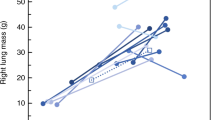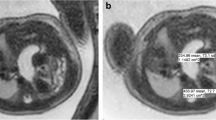Abstract
Background
In congenital diaphragmatic hernia (CDH), there is pulmonary hypoplasia (PH) and also pulmonary vascular and bronchial abnormalities. Few studies have investigated bronchial maldevelopment in CDH. We evaluated bronchial area (BA) by bronchography in a fetal lamb DH model to develop a measure of PH.
Methods
We created DH in fetal lambs at 75 days gestation, delivering by cesarean section and killing them at term (DH, n = 12). Normal term fetuses provided controls (C, n = 5). We measured total lung volume (TLV) and performed barium bronchography. Using image analysis, BA, total lung area (TLA) and bronchial area/lung area ratio (B/L ratio) were calculated. Student’s T test (p < 0.05; significant) and Spearman's correlation coefficient were performed.
Results
TLV (ml) was 133.3 ± 41.2 in DH and 326 ± 22.5 in C (p = 0.0000001). TLA (cm2) was 78.8 ± 17.4 in DH and 107.1 ± 10.3 in C (p = 0.006). BA (cm2) was 39.6 ± 11.9 in DH and 52.2 ± 7.7 in C (p = 0.019). The B/L ratio was 0.45 ± 0.06 in DH and 0.49 ± 0.05 in C (p = 0.28). There are correlations in DH between TLV and TLA (r = 0.79), TLV and BA (r = 0.73) and in C between TLV and TLA (r = 0.97) and TLV and BA (r = 0.67).
Conclusion
It may be possible to assess PH on fetal MRI, given the correlation between TLV and TLA, and TLV and BA.



Similar content being viewed by others
References
Leeuwen L, Fitzgerald DA (2014) Congenital diaphragmatic hernia. J Paediatr Child Health 50:667–673. https://doi.org/10.1111/jpc.12508
Kitagawa M, Hislop A, Boyden EA, Reid L (1971) Lung hypoplasia in congenital diaphragmatic hernia. A quantitative study of airway, artery, and alveolar development. Br J Surg 58:342–346
Reid L (1977) 1976 Edward B.D. Neuhauser lecture: The lung: growth and remodeling in health and disease. AJR Am J Roentgenol 129:777–788. https://doi.org/10.2214/ajr.129.5.777
Nose K, Kamata S, Sawai T, Tazuke Y, Usui N, Kawahara H, Okada A (2000) Airway anomalies in patients with congenital diaphragmatic hernia. J Pediatr Surg 35:1562–1565. https://doi.org/10.1053/jpsu.2000.18310
Shehata SM, Tibboel D, Sharma HS, Mooi WJ (1999) Impaired structural remodelling of pulmonary arteries in newborns with congenital diaphragmatic hernia: a histological study of 29 cases. J Pathol 189:112–118. https://doi.org/10.1002/(SICI)1096-9896(199909)189:1%3c112:AID-PATH395%3e3.0.CO;2-8
Harrison MR, Keller RL, Hawgood SB, Kitterman JA, Sandberg PL, Farmer DL, Lee H, Filly RA, Farrell JA, Albanese CT (2003) A randomized trial of fetal endoscopic tracheal occlusion for severe fetal congenital diaphragmatic hernia. N Engl J Med 349:1916–1924. https://doi.org/10.1056/NEJMoa035005
Deprest J, Brady P, Nicolaides K, Benachi A, Berg C, Vermeesch J, Gardener G, Gratacos E (2014) Prenatal management of the fetus with isolated congenital diaphragmatic hernia in the era of the TOTAL trial. Semin Fetal Neonatal Med 19:338–348. https://doi.org/10.1016/j.siny.2014.09.006
Torrents-Barrena J, Piella G, Masoller N, Gratacos E, Eixarch E, Ceresa M, Ballester MAG (2019) Segmentation and classification in MRI and US fetal imaging: Recent trends and future prospects. Med Image Anal 51:61–88. https://doi.org/10.1016/j.media.2018.10.003
Weis M, Hoffmann S, Henzler C, Weiss C, Schoenberg SO, Schaffelder R, Schaible T, Neff KW (2018) Isolated impact of liver herniation on outcome in fetuses with congenital diaphragmatic hernia—a matched-pair analysis based on fetal MRI relative lung volume. Eur J Radiol 105:148–152. https://doi.org/10.1016/j.ejrad.2018.05.024
Metkus AP, Filly RA, Stringer MD, Harrison MR, Adzick NS (1996) Sonographic predictors of survival in fetal diaphragmatic hernia. J Pediatr Surg 31:148–151 (discussion 151–2)
Yokoi A, Ohfuji S, Yoshimoto S, Sugioka Y, Akasaka Y, Funakoshi T (2018) A new approach to risk stratification using fetal MRI to predict outcomes in congenital diaphragmatic hernia: the preliminary retrospective single institutional study. Transl Pediatr 7:356–361. https://doi.org/10.21037/tp.2018.09.01
Obayashi J, Kawaguchi K, Koike J, Tanaka K, Seki Y, Nagae H, Manabe S, Ohyama K, Takagi M, Kitagawa H et al (2017) Evaluation of alveolar epithelial cells in the sheep model of congenital diaphragmatic hernia: type 1 alveolar epithelial cells and histopathological image analysis. J Pediatr Surg 52:2074–2077. https://doi.org/10.1016/j.jpedsurg.2017.08.034
Soper Robert T, Pringle Kevin C, Scofield John C (1984) Creation and repair of diaphragmatic hernia in the fetal lamb: techniques and survival. J Pediatr Surg 19:33–40
Tanaka K, Koike J, Obayashi J, Seki Y, Nagae H, Manabe S, Ohyama K, Sasaki C, Takagi M, Zuccollo J et al (2015) Pressure limited vesico-amniotic shunt allows normal lung growth in a fetal lamb model of obstructive uropathy. J Pediatr Surg 50:2063–2067. https://doi.org/10.1016/j.jpedsurg.2015.08.029
Schneider CA, Rasband WS, Eliceiri KW (2012) NIH Image to ImageJ: 25 years of image analysis. Nat Methods 9:671–675
Daly AB, Wallis JM, Borg ZD, Bonvillain RW, Deng B, Ballif BA, Jaworski DM, Allen GB, Weiss DJ (2012) Initial binding and recellularization of decellularized mouse lung scaffolds with bone marrow-derived mesenchymal stromal cells. Tissue Eng Part A 18:1–16. https://doi.org/10.1089/ten.TEA.2011.0301
George DK, Cooney TP, Chiu BK et al (1987) Hypoplasia and immaturity of the terminal lung unit in congenital diaphragmatic hernia. Am J Respir Crit Care Med 136:947–950
O’Rourke PP, Vacanti JP, Crone RK et al (1988) Use of the postductal PaO2 as a predictor of pulmonary vascular hypoplasia in infants with congenital diaphragmatic hernia. J Pediatr Surg 23:904–907
Wilson JM, Lund DP, Lillehei CW et al (1991) Congenital diaphragmatic hernia. Predictor of severity in the ECMO era. J Pediatr Surg 26:1028–1034
Schopper MA, Walkup LL, Tkach JA, Higano NS, Lim FY, Haberman B, Woods JC, Kingma PS (2017) Evaluation of neonatal lung volume growth by pulmonary magnetic resonance imaging in patients with congenital diaphragmatic hernia. J Pediatr 188:96–102.e1. https://doi.org/10.1016/j.jpeds.2017.06.002
Cannie MM, Cordier AG, De Laveaucoupet J, Franchi-Abella S, Cagneaux M, Prodhomme O, Senat MV, Mokhtari M, Vlieghe V, Nowakowska D et al (2013) Liver-to-thoracic volume ratio: use at MR imaging to predict postnatal survival in fetuses with isolated congenital diaphragmatic hernia with or without prenatal tracheal occlusion. Eur Radiol 23:1299–1305. https://doi.org/10.1007/s00330-012-2709-6
Nishie A, Tajima T, Asayama Y, Ishigami K, Hirakawa M, Nakayama T, Ushijima Y, Kakihara D, Okamoto D, Yoshiura T et al (2009) MR prediction of postnatal outcomes in left-sided congenital diaphragmatic hernia using right lung signal intensity: comparison with that using right lung volume. J Magn Reson Imaging 30:112–120. https://doi.org/10.1002/jmri.21829
Tonni G, Ruano R, Sa R, Peixoto Filho FM, Lopes J, Werner H (2018) 3D virtual bronchoscopy before FETO procedure in a fetus with severe, isolated left congenital diaphragmatic hernia. Fetal Pediatr Pathol 37:134–139. https://doi.org/10.1080/15513815.2018.1445148
Johns CS, Swift AJ, Hughes PJC, Ohno Y, Schiebler M, Wild JM (2017) Pulmonary MR angiography and perfusion imaging—a review of methods and applications. Eur J Radiol 86:361–370. https://doi.org/10.1016/j.ejrad.2016.10.003
Acknowledgements
Management of the animals in the laboratory was supervised by Dr. Rebecca Dyson and Taylor Wilson, animal technicians at the BRU at University of Otago, Wellington. The ewes were bred by Mr. Denis Taylor, who also managed the flock on the farm between procedures. The authors thank Shigeko Ohnuma and the other staff in the Department of Pathology St. Marianna University School of Medicine for assistance in processing the histology.
Funding
This study was supported by the Japanese Society for Grant-in-aid of Scientific Research.
Author information
Authors and Affiliations
Corresponding author
Ethics declarations
Conflict of interest
The authors declare that they have no competing interest.
Additional information
Publisher's Note
Springer Nature remains neutral with regard to jurisdictional claims in published maps and institutional affiliations.
Rights and permissions
About this article
Cite this article
Kawaguchi, T., Kawaguchi, K., Obayashi, J. et al. A new approach using image analysis to assess pulmonary hypoplasia in the fetal lamb diaphragmatic hernia model. Pediatr Surg Int 35, 1131–1136 (2019). https://doi.org/10.1007/s00383-019-04543-9
Accepted:
Published:
Issue Date:
DOI: https://doi.org/10.1007/s00383-019-04543-9




